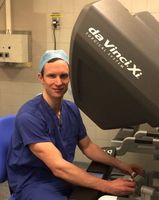Central Auckland > Private Hospitals & Specialists > Southern Cross Hospitals >
Southern Cross Brightside Hospital - Urology
Private Surgical Service, Urology
Description
Southern Cross' Brightside Hospital is a modern private surgical hospital located in central Auckland.
Brightside Hospital was originally established on its Auckland site, in Epsom, in the 1940s and was completely rebuilt to modern, high tech specifications and re-opened in 2000.
Brightside offers a wide range of surgical services and postoperative care to around 4,500 patients each year. This four-theatre hospital provides 43 inpatient beds and 6 day stay chairs and has a staff of nearly 100.
With an established reputation for gynaecological, orthopaedic and urological services, Brightside was also the first private hospital in New Zealand to offer prostate brachytherapy, a new type of treatment for prostate cancer. This specialist service employs advanced techniques and technologies for prostate implants, and the medical specialists operating at the hospital have helped Brightside to be involved in leading the way in urological treatment in New Zealand in some respects.
Plastic surgery, oral surgery and general surgery are also amongst the surgical services offered at Brightside Hospital.
Recent developments include the introduction of an Intermediate Care Facility (ICF), opened in 2012 and providing a specialised postoperative ward for patients with medical conditions or surgical issues that require an enhanced level of monitoring and care. The four-bed ward caters for patients who unexpectedly require some extra post-surgical care, or those with medical issues - such as heart or blood pressure conditions - that may have the potential to cause complications during or after surgery.
Consultants
-

Mr Imran Ali
Urologist
-

Mr Jason Du
Urologist
-

Dr Eva Fong
Urologist
-

Mr Madhu Koya
Urologist
-
Dr Sum Sum Lo
Urogynaecologist
-

Mr David Merrilees
Urologist
-

Mr Ian Mundy
Urologist
-

Mr John Tuckey
Urologist
-

Mr Simon van Rij
Urologist
-

Dr Andrew Williams
Urologist
-

Associate Professor Kamran Zargar
Urologist
Procedures / Treatments
Prostate cancer can be treated with localised radiotherapy by implanting small radioactive seeds into the prostate gland.
Prostate cancer can be treated with localised radiotherapy by implanting small radioactive seeds into the prostate gland.
Prostate cancer can be treated with localised radiotherapy by implanting small radioactive seeds into the prostate gland.
The foreskin is pulled away from the body of the penis and cut off, exposing the underlying head of the penis (glans). Stitches may be required to keep the remaining edges of the foreskin in place.
The foreskin is pulled away from the body of the penis and cut off, exposing the underlying head of the penis (glans). Stitches may be required to keep the remaining edges of the foreskin in place.
The foreskin is pulled away from the body of the penis and cut off, exposing the underlying head of the penis (glans). Stitches may be required to keep the remaining edges of the foreskin in place.
Incisions (cuts) are made in the abdomen (stomach) to allow access to your bladder. The vagina is lifted and attached to the pelvis wall, allowing the bladder neck to be supported, thus correcting urine leakage.
Incisions (cuts) are made in the abdomen (stomach) to allow access to your bladder. The vagina is lifted and attached to the pelvis wall, allowing the bladder neck to be supported, thus correcting urine leakage.
Incisions (cuts) are made in the abdomen (stomach) to allow access to your bladder. The vagina is lifted and attached to the pelvis wall, allowing the bladder neck to be supported, thus correcting urine leakage.
A long, thin tube with a tiny camera attached (cystoscope) is inserted into the urinary opening and through the urethra (the tube that carries urine from your bladder to the outside of your body) to your bladder. This allows the urologist to view any abnormalities in your lower urinary tract and, if necessary, take a small tissue sample to look at under the microscope (biopsy).
A long, thin tube with a tiny camera attached (cystoscope) is inserted into the urinary opening and through the urethra (the tube that carries urine from your bladder to the outside of your body) to your bladder. This allows the urologist to view any abnormalities in your lower urinary tract and, if necessary, take a small tissue sample to look at under the microscope (biopsy).
A long, thin tube with a tiny camera attached (cystoscope) is inserted into the urinary opening and through the urethra (the tube that carries urine from your bladder to the outside of your body) to your bladder. This allows the urologist to view any abnormalities in your lower urinary tract and, if necessary, take a small tissue sample to look at under the microscope (biopsy).
Incisions (cuts) are made in the side of the body, between the ribs and hip, to allow removal of one or both kidneys.
Incisions (cuts) are made in the side of the body, between the ribs and hip, to allow removal of one or both kidneys.
Incisions (cuts) are made in the side of the body, between the ribs and hip, to allow removal of one or both kidneys.
A tube is inserted into the kidney to allow urine to drain out. The tube may drain into a bag on the outside of your body (on your back) or may drain inside your body into the bladder.
A tube is inserted into the kidney to allow urine to drain out. The tube may drain into a bag on the outside of your body (on your back) or may drain inside your body into the bladder.
A tube is inserted into the kidney to allow urine to drain out. The tube may drain into a bag on the outside of your body (on your back) or may drain inside your body into the bladder.
A small incision (cut) is made in the groin on the side of the undescended testicle and the testicle pulled down into the scrotum. Sometimes a small cut will need to be made in the scrotum as well.
A small incision (cut) is made in the groin on the side of the undescended testicle and the testicle pulled down into the scrotum. Sometimes a small cut will need to be made in the scrotum as well.
A small incision (cut) is made in the groin on the side of the undescended testicle and the testicle pulled down into the scrotum. Sometimes a small cut will need to be made in the scrotum as well.
Scrotal: a small incision (cut) is made in the front of the scrotum and the testicles removed. This greatly reduces the amount of testosterone produced in the body. Inguinal: an incision is made in the groin to remove a testicle that: is undescended from childhood, has wasted away (atrophied), or has a tumour.
Scrotal: a small incision (cut) is made in the front of the scrotum and the testicles removed. This greatly reduces the amount of testosterone produced in the body. Inguinal: an incision is made in the groin to remove a testicle that: is undescended from childhood, has wasted away (atrophied), or has a tumour.
Scrotal: a small incision (cut) is made in the front of the scrotum and the testicles removed. This greatly reduces the amount of testosterone produced in the body.
Inguinal: an incision is made in the groin to remove a testicle that: is undescended from childhood, has wasted away (atrophied), or has a tumour.
A thin wire is inserted into your lower back and guided using x-ray imaging to your kidney. A small incision (cut) is then made on your back and a narrow tube is inserted and follows the guide wire to the kidney. The kidney stone(s) is then removed or broken up.
A thin wire is inserted into your lower back and guided using x-ray imaging to your kidney. A small incision (cut) is then made on your back and a narrow tube is inserted and follows the guide wire to the kidney. The kidney stone(s) is then removed or broken up.
A thin wire is inserted into your lower back and guided using x-ray imaging to your kidney. A small incision (cut) is then made on your back and a narrow tube is inserted and follows the guide wire to the kidney. The kidney stone(s) is then removed or broken up.
Incisions (cuts) are made in either the lower abdomen (stomach) or between the scrotum and the anus to allow removal of the enlarged parts of, or the entire, prostate gland.
Incisions (cuts) are made in either the lower abdomen (stomach) or between the scrotum and the anus to allow removal of the enlarged parts of, or the entire, prostate gland.
Incisions (cuts) are made in either the lower abdomen (stomach) or between the scrotum and the anus to allow removal of the enlarged parts of, or the entire, prostate gland.
Sling procedures are common surgical operations to stop stress incontinence. This is a condition where urine leaks out when movements, such as coughing, laughing or sneezing put pressure on the bladder. Stress incontinence occurs when the muscles supporting the urethra (tube that carries the urine out of the body) become weak and the urethra no longer works well as a valve to keep the urine in the bladder. Sometimes this results from the effects of childbirth. Sling procedures provide support to the weakened muscles so the urethra won’t accidentally release urine when there is pressure on the bladder. Burch Procedure (colposuspension) In the Burch procedure, permanent stitches are placed on both sides of the urethra to give it more support. The Burch procedure is done under a general anaesthetic (you sleep throughout the procedure) and can be performed by laparoscopic surgery. Natural or Biological Tissue Sling A sling from your own abdominal wall or from biological material of animal origin is used to lift the urethra.
Sling procedures are common surgical operations to stop stress incontinence. This is a condition where urine leaks out when movements, such as coughing, laughing or sneezing put pressure on the bladder. Stress incontinence occurs when the muscles supporting the urethra (tube that carries the urine out of the body) become weak and the urethra no longer works well as a valve to keep the urine in the bladder. Sometimes this results from the effects of childbirth. Sling procedures provide support to the weakened muscles so the urethra won’t accidentally release urine when there is pressure on the bladder. Burch Procedure (colposuspension) In the Burch procedure, permanent stitches are placed on both sides of the urethra to give it more support. The Burch procedure is done under a general anaesthetic (you sleep throughout the procedure) and can be performed by laparoscopic surgery. Natural or Biological Tissue Sling A sling from your own abdominal wall or from biological material of animal origin is used to lift the urethra.
Sling procedures are common surgical operations to stop stress incontinence. This is a condition where urine leaks out when movements, such as coughing, laughing or sneezing put pressure on the bladder. Stress incontinence occurs when the muscles supporting the urethra (tube that carries the urine out of the body) become weak and the urethra no longer works well as a valve to keep the urine in the bladder. Sometimes this results from the effects of childbirth. Sling procedures provide support to the weakened muscles so the urethra won’t accidentally release urine when there is pressure on the bladder.
Burch Procedure (colposuspension)
In the Burch procedure, permanent stitches are placed on both sides of the urethra to give it more support. The Burch procedure is done under a general anaesthetic (you sleep throughout the procedure) and can be performed by laparoscopic surgery.
Natural or Biological Tissue Sling
A sling from your own abdominal wall or from biological material of animal origin is used to lift the urethra.
A long, thin tube with a tiny camera attached (resectoscope) is inserted into the urinary opening, through the urethra and into the bladder. Instruments are passed through the resectoscope and the tumour removed.
A long, thin tube with a tiny camera attached (resectoscope) is inserted into the urinary opening, through the urethra and into the bladder. Instruments are passed through the resectoscope and the tumour removed.
A long, thin tube with a tiny camera attached (resectoscope) is inserted into the urinary opening, through the urethra and into the bladder. Instruments are passed through the resectoscope and the tumour removed.
A long, thin tube with a tiny camera attached (resectoscope) is inserted into the urinary opening of the penis and through the urethra (the tube that carries urine from your bladder to the outside of your body) to your bladder. The urologist is then able to view the prostate gland and, by passing an instrument through the resectoscope, is able to remove the part of the gland that has become enlarged.
A long, thin tube with a tiny camera attached (resectoscope) is inserted into the urinary opening of the penis and through the urethra (the tube that carries urine from your bladder to the outside of your body) to your bladder. The urologist is then able to view the prostate gland and, by passing an instrument through the resectoscope, is able to remove the part of the gland that has become enlarged.
A long, thin tube with a tiny camera attached (resectoscope) is inserted into the urinary opening of the penis and through the urethra (the tube that carries urine from your bladder to the outside of your body) to your bladder. The urologist is then able to view the prostate gland and, by passing an instrument through the resectoscope, is able to remove the part of the gland that has become enlarged.
An incision (cut) is made in the penis and the narrowed part of the urethra (the tube that carries urine to the outside of your body) is removed and the urethra rejoined. In balloon urethroplasty, a thin tube with a balloon attached is inserted into the opening of the penis. When it reaches the narrowed part of the urethra, the balloon is inflated, thus widening the urethra.
An incision (cut) is made in the penis and the narrowed part of the urethra (the tube that carries urine to the outside of your body) is removed and the urethra rejoined. In balloon urethroplasty, a thin tube with a balloon attached is inserted into the opening of the penis. When it reaches the narrowed part of the urethra, the balloon is inflated, thus widening the urethra.
An incision (cut) is made in the penis and the narrowed part of the urethra (the tube that carries urine to the outside of your body) is removed and the urethra rejoined. In balloon urethroplasty, a thin tube with a balloon attached is inserted into the opening of the penis. When it reaches the narrowed part of the urethra, the balloon is inflated, thus widening the urethra.
An incision (cut) is made in the penis and the narrowed part of the urethra (the tube that carries urine to the outside of your body) is removed and the urethra rejoined. In balloon urethroplasty, a thin tube with a balloon attached is inserted into the opening of the penis. When it reaches the narrowed part of the urethra, the balloon is inflated, thus widening the urethra.
An incision (cut) is made in the penis and the narrowed part of the urethra (the tube that carries urine to the outside of your body) is removed and the urethra rejoined. In balloon urethroplasty, a thin tube with a balloon attached is inserted into the opening of the penis. When it reaches the narrowed part of the urethra, the balloon is inflated, thus widening the urethra.
An incision (cut) is made in the penis and the narrowed part of the urethra (the tube that carries urine to the outside of your body) is removed and the urethra rejoined.
In balloon urethroplasty, a thin tube with a balloon attached is inserted into the opening of the penis. When it reaches the narrowed part of the urethra, the balloon is inflated, thus widening the urethra.
A tiny incision (cut) is made in the scrotum and a short length of the vas deferens (the tube carrying sperm away from the testicles where it is produced) is removed.
A tiny incision (cut) is made in the scrotum and a short length of the vas deferens (the tube carrying sperm away from the testicles where it is produced) is removed.
A tiny incision (cut) is made in the scrotum and a short length of the vas deferens (the tube carrying sperm away from the testicles where it is produced) is removed.
Visiting Hours
- Weekdays: 11:00 to 20:00
- Weekends: 11:00 to 20:00
Parking
Free visitor parking is provided at the hospital.
Contact Details
Southern Cross Brightside Hospital
Central Auckland
-
Phone
(09) 925 4200
Email
Website
Surgeons can be contacted at their private consultation rooms.
3 Brightside Road
Epsom
Auckland 1023
Street Address
3 Brightside Road
Epsom
Auckland 1023
Postal Address
PO Box 26064
Epsom
Auckland 1344
Was this page helpful?
This page was last updated at 2:48PM on October 10, 2025. This information is reviewed and edited by Southern Cross Brightside Hospital - Urology.

